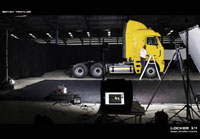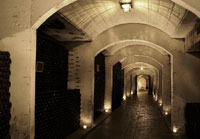It can be difficult to put your finger on, but when you see it you know it: “something special”. You can take two pictures and put them side by side: both high res, both sharp, both obeying all the rules of composition and framing, but one will jump out at you, the other won't.
According to Traylor, top-level professional photography is a wildly different world from “good enough” professional photography. “Good enough” means you've got the basics right technically. To do top-level work, you first have to have that indefinable “specialness”, but you also have to have iron-clad, rock-solid, no-compromise consistency of quality and repeatability.
You have to be “picture perfect”, not once, but every time, even when your photo shoots in a particular series have to move between locations, or where products or people are shot days or months apart. If you're spending hundreds of thousands of rands on a slick, glossy brochure, every single element must be perfect, and the look must be flawlessly repeatable. If you must do a re-shoot because a single product's design has changed, it must still look stylistically exactly like the all the others in the range photographed. If you need to use multiple locations to be able to get the pics you need, you often also have to be able to exactly reproduce the lighting and textures in each shot to ensure your storyline is not compromised.
The technical skill needed here is enormous, says Traylor, and a sense of how lighting can be manipulated is critical, because something as subtle as a change in cloud cover on a particular day can completely change the look and feel of an image. A particularly pleasing lighting setup at one location may be exceptionally difficult to duplicate at another, possible months later.
To illustrate some of the technical, logistic and artistic difficulties that have to be overcome, Traylor took us through some of his most recent shoots.
This shoot for Mitsubishi FUSO (the gigantic truck-manufacturing division of Mitsubishi) was commissioned by its agency, the Old Shanghai Firecracker Factory, to give it high quality images for adverts and brochures. The challenge for Mitsubishi FUSO is that its trucks are generally custom-built to order, so it doesn't have a showroom full of shiny rigs to entice customers. This means a heavy requirement for high quality images for various collateral.
Brief: High quality, slick, but no-nonsense images that would appeal to commercial fleet buyers and transport operators, with a variety of angles and compositions to allow use in a multitude of marketing activities.
Challenges: Trucks are big. Sometimes very big, which means needing a very large studio space and lots of lighting equipment. Shooting vehicles is technically very challenging because they're essentially one huge reflective surface. To add even more complexity, not all models were available at the same time, meaning three separate shoots - but with an identical look.
Traylor's solution: The first time the trucks were shot was in a storage depot in East London, the hometown of Mercedes-Benz SA (which exports and manufactures Mitsubishi world wide). They had to freight all the lighting and grip equipment from Cape Town to East London, two Mercedes Vito vans full of equipment. You can imagine the time, cost and production to get it there. They organised a large section of the warehouse to be blacked out with staging pipe and drape so that they could hide everything they didn't want to see. Then they built seven metres of scaffolding to be able to get the angles required for the brief.
They stayed for 10 days the first time. The second shoot took five days, and then the final shoot had to take place in Johannesburg. Traylor had to find a large enough studio in which he had to match the look and feel from the past locations with the same lighting and reflections. “It was a huge production and the client is over the moon with the results. They're great clients to work for,” he says.

Ford Motor Company had partnered with Touchline Media to do a classy, stylish advertorial series to highlight its new cars, along with some luxury brand items (apparel and accessories). Each ad had to convey a lifestyle element that enhanced the car's image. The campaign is due to run as double-page spreads in Men's Health, SA Sports Illustrated, Golf Digest and Shape.
Brief: Budgets were tight, deadlines were tighter. Shots had to be varied to allow designers to produce great looking layouts while keeping the car as the focal point of each shot. The trick was to balance each shot, not allow any focal point to be in the page split and at the same time leave space for thumbnail detail shots and copy.
Challenges: The team was on site in two different locations ever yday, so the set up and break down timings had to be perfect in order to make it to the next location and get ready to do the next shot. Monday was 37°C; Tuesday was a howling Southeaster all day, then another scorching 36°C on Wednesday. All shots had two models, props, makeup and wardrobe. On top of this, the team had to clean and create each setting or background they shot in, because they didn't have the time or budget to recce the locations beforehand.
Traylor's solution: “Sometimes you can't play just the photographer, from time to time it requires you to get your hands dirty to make the shot happens - this was one of those shoots. You just got to make a plan and get the job done. Experience counts for a lot here, where the team can make very good educated guesses about what's going to happen, and then just be flexible and fast on your feet on-site. This kind of photography is all about backup plans and thinking way ahead...”

The Bergkelder wine estate in Stellenbosch has a fantastic wine tour, where visitors are taken right through the winemaking process from grape to bottle. The company needed more images for its marketing material, especially of the depths of its cellars - a dark, close environment that's got almost no electric lighting; it's all romantically candle-lit. Great for tourists. Not great for photographers.
Brief: Get strong, dramatic pictures that tell the whole story, and show the whole picture - dark, shiny bottles in dark shadows, bright candles, scattered accent lighting.
Challenges: Light and dark are the photographer's friends, and worst enemy. The challenge here is finding the balance that maximises visibility, but still keeps texture and drama.
Traylor's solution: “This was challenging because of how dark the hallways and rooms are; only candlelight and a couple of spots basically light them. To maintain depth in the picture as well as expose many elements, I used existing light coupled with strobe and candlelight. The trick was to balance the light forms. We ended up exposing ten different frames to capture the hallway and create the overall look.”
